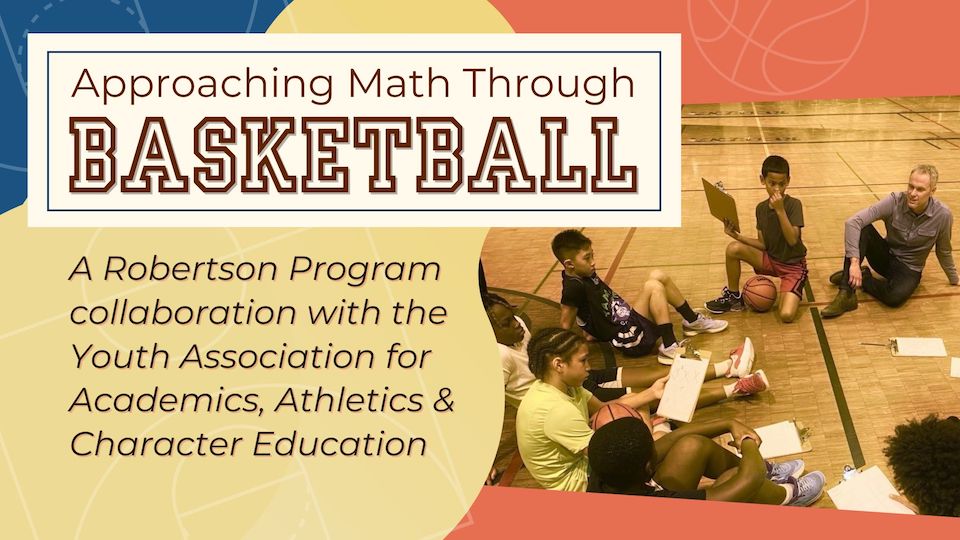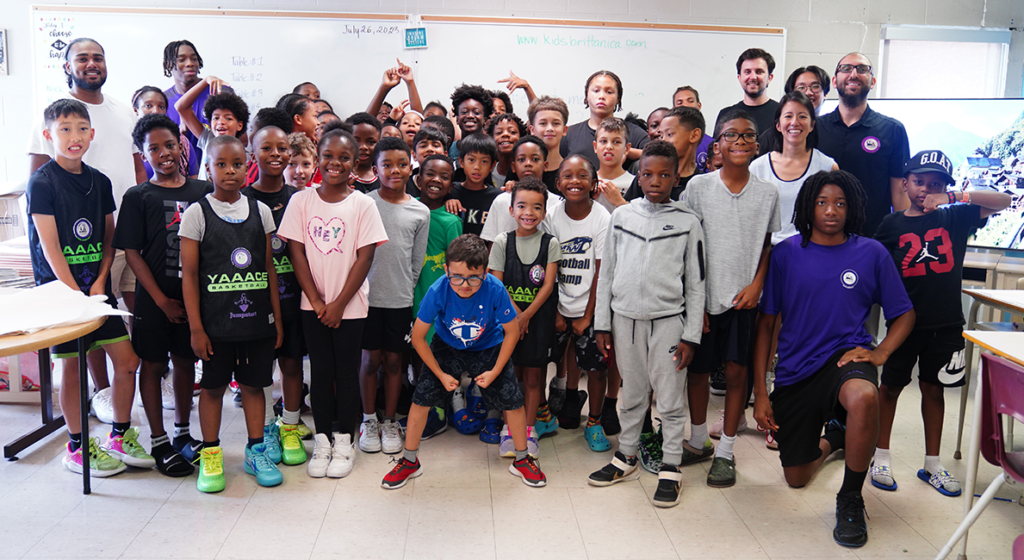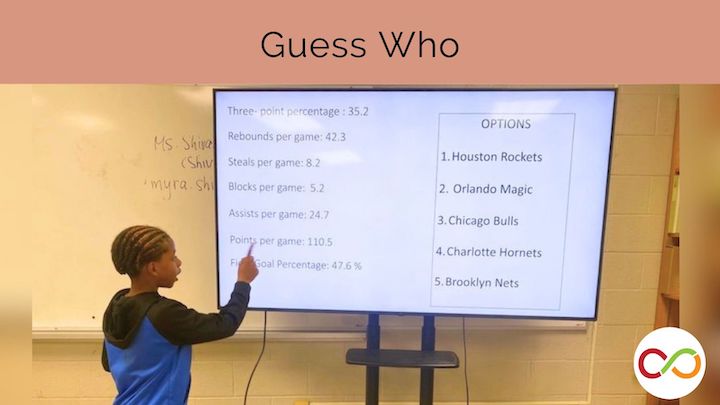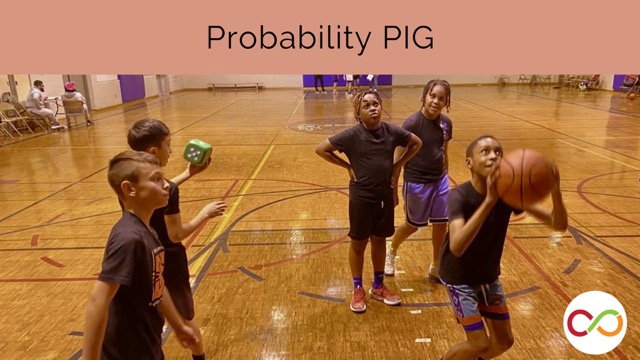

This year, The Robertson Program teamed up with the Youth Association for Academics, Athletics, and Character Education (YAAACE) for an innovative, exploratory initiative: Approaching Math Through Basketball. Following the success of our collaboration during their 2023 summer camp, we set our sights on a fresh objective: developing a series of engaging activities aimed at fostering a deeper understanding of probability and statistics among members of YAAACE’s fifth-grade competitive basketball team.
At the heart of our approach lies a fundamental truth: Young learners thrive when learning emerges from their passions and interests (Wang & Eccles, 2012). YAAACE’s basketball program engages youth who demonstrate an unwavering dedication to their favourite sport, investing countless hours each week to develop their basketball skills. YAAACE also fosters the personal development of its youth off the court through various academic programs. The Robertson Program’s dedication to providing engaging, evidence-based learning experiences for children in Ontario made us a perfect match for this partnership, in line with YAAACE’s mission of providing culturally reflective programs that address the educational disparities in racialized and underprivileged communities.
“By making math more fun through inquiry, relevant to everyday circumstances such as playing basketball, and culturally responsive in pedagogy, we seek to mitigate the underachievement and lack of representation of Black students in the STEM field,” says YAAACE Executive Director Dr. Ardavan Eizadirad.
Youth Association for Academics, Athletics & Character Education
A Toronto-based, black-led organization, YAAACE supports youth from underserved communities through academics and athletics programming.
Research has revealed a disconnect between the mathematics children are able to perform outside of school (context-dependent mathematics) and mathematics learning in school-based settings. A study of youth basketball players found that, although the players could solve data literacy problems within the context of basketball, they would struggle to answer comparable problems in math class (Nasir, 2000). In our project, we had children estimate and calculate their own free throw percentages, offering opportunity to not only develop knowledge and practice in calculating percentages, but also as a way of experiencing and appreciating the relevance of mathematics.
“Statistics such as free throw percentage, field goal percentage, and average assists per game lend themselves beautifully to mathematical discussions and explorations of these concepts,” says Dr. Zack Hawes, director of the Mathematical Thinking Lab at OISE and a partner in the Approaching Math Through Basketball project. “Then there’s concepts and principles such as the law of large numbers, the gambler’s fallacy, and theoretical vs. experimental probability that also permeate the game of basketball. For example, is there such a thing as a hot streak?”
Each session had a combination of in-classroom and on-the-court activities all targeting probability and statistical learning. A popular activity challenged the team to match data, such as three-point percentages and points per game, to the NBA player or team it represented. This required students to consider statistical data to determine an outcome and would often lead to lively discussion amongst the players. “It was clear the children regularly engaged in mathematical thinking while watching and playing basketball. There were many heated conversations about which NBA players or teams were ‘better’ – debates that centered around the use of statistics to justify one’s position. At other times, players were quick to draw on their knowledge of basketball to approach statistics-based problems posed to the group,” says Dr. Hawes. “For example, when asked whether shooting seven for 17 is considered ‘good,’ players drew from both their personal experiences in basketball as well as their mathematical knowledge to make sense of the question. One child said it was okay because that’s what Steph Curry shot the night before and it was less than a 50 per cent field goal percentage. Another child reasoned that seven for 17 is less than a 50 per cent shooting percentage because seven for 14 would be exactly 50 per cent. Based on this, he estimated that shooting seven for 17 is about 41-43 percent.”
We also wanted to use principles of embodied cognition to create a whole-body learning experience for children. On-court activities were designed to stimulate this experience. Children engaged in various probability and statistical games that paralleled the process of determining statistics for professional basketball players and teams. Whether in the classroom or on the basketball court, the team was challenged to calculate and determine probabilities much like analysts do for the pros. Using both classroom and on-the-court activities allowed us to holistically build on children’s strengths and mathematical knowledge.
Our new partnership with YAAACE yielded fresh insights into children’s diverse approaches to mathematical learning. “We always appreciate the opportunity to collaborate with community organizations that share in our passion for creating new opportunities to engage children in math education,” says Robertson Program Director Dr. Larisa Lam. “We thoroughly enjoyed connecting with each member of YAAACE’s Grade 5 basketball team and look forward to future collaborations where we can leverage children’s passions and strengths to enhance mathematics achievement.”
One activity the team really enjoyed was “Guess Who”. It challenges students to match data, such as three-point percentages and points per game, to the NBA player or team it represents.
One activity we tried on the basketball court was “Probability PIG.” Similar to the classic game of PIG, which requires players to decide whether to continue playing a game using probability, this version requires students to also consider the likelihood they will be able to sink the ball from a specific position on the court.
The Robertson Program and YAAACE wish to also thank educators at the Dr. Eric Jackman Institute of Child Study for their insightful contributions about children’s comprehension of fractions and statistics at the Grade 5 level.

Tanya Kaur Talwar
Research Assistant
The Mathematical Thinking Lab and The Robertson Program for Inquiry-based Teaching in Math and Science

Zachary Pedersen
Program Manager
The Robertson Program for Inquiry-based Teaching in Math and Science
References
Nasir, N. S. (2000). Points ain’t everything: Emergent goals and average basketball in a below-average math class. Anthropology & Education Quarterly, 31(3), 295-323.
Wang, Z., Shakeshaft, N., Schofield, K., & Malanchini, M. (2018). Anxiety is not enough to drive me away: A latent profile analysis on math anxiety and math motivation. PloS one, 13(2), e0192072.



